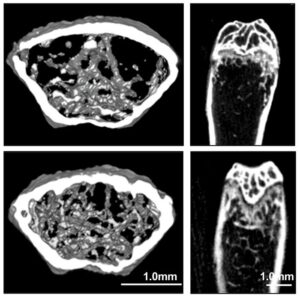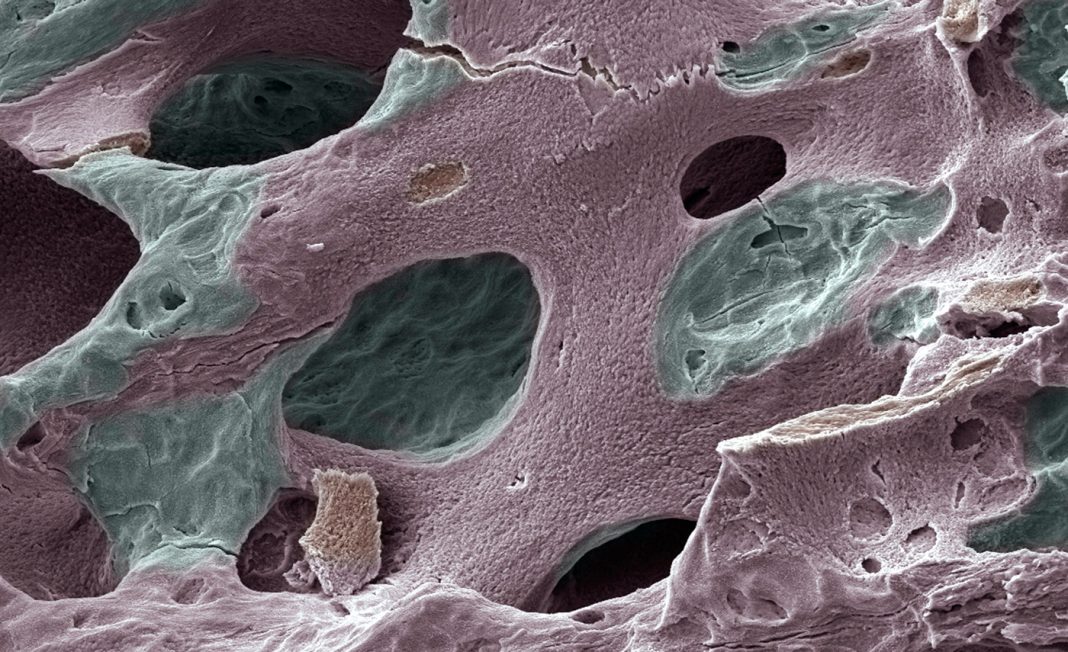Researchers headed by a team at Peking University International Cancer Center and at Peking University School and Hospital for Stomatology, used a deep learning algorithm to identify the antimalarial drug dihydroartemisinin (DHA), which is a derivative of a traditional Chinese medicine, as a potential treatment for osteoporosis. The team’s studies in live mice showed that DHA effectively reversed osteoporosis-related bone loss by helping to maintain the “stemness” of bone marrow mesenchymal stem cells (BMMSCs).
Reporting in ACS Central Science (“Deep Learning-Predicted Dihydroarteminsinin Rescues Osteoporosis by Maintaining Mesenchymal Stem Cell Stemness through Activating Histone 3 Lys 9 Acetylation,”) the team said their collective studies suggested that “… DHA could be a promising therapeutic agent for treating osteoporosis by maintaining BMMSC stemness.”
Osteoporosis is a degenerative disease that affects the skeletal system and is characterized by the loss of bone density and destruction of the bone microstructure. In healthy people, there is a balance between the osteoblasts that build new bone and osteoclasts that break it down. But when the “demolition crew” becomes overactive, it can result in bone loss and osteoporosis, which typically affects older adults. BMMSCs, which are the precursors of osteoblasts, play a crucial role in osteoporosis, the authors wrote. “BMMSCs maintain a constant flow of functional osteoblasts by committed differentiation and a local population through steady proliferation and refreshment, which together constitute the stemness of BMMSCs under physiological motion.” Maintaining the stemness of BMMSCs is thus “crucial for bone homeostasis and regeneration,” they continued.
However, during osteoporosis, these multipotent cells tend to turn into fat-creating adipocytes and have “diminished regenerative potential,” the authors continued. “Because BMMSCs provide a continuous supply of osteoblasts for bone repair, it is critical to find ways to restore their functions.”
Previously, Zhengwei Xie, PhD, at Peking University, and colleagues, trained a deep learning algorithm to predict cellular responses with drug treatment and eventually accurately predicted the efficacies of new drugs by comparing the changes in gene expression profiles of diseased and drug-treated cells. “This deep learning-based efficacy prediction system (DLEPS) has already been successful in discovering new drugs for a range of diseases, including obesity, hyperuricemia, and NASH.” For their newly reported study, the investigators, joined by Yan Liu, PhD, and Weiran Li, PhD, at Peking University School and Hospital for Stomatology, wanted to use the algorithm to find a new treatment strategy for osteoporosis that focused on BMMSCs.
The team ran the program on a profile of differently expressed genes (DEGs) in newborn and adult mice. One of the top-ranked compounds identified was DHA, a derivative of artemisinin and a key component of malaria treatments. “From the top-ranked candidates, we identified dihydroartemisinin (DHA), a traditional Chinese herbal extract that can promote BMMSC stemness, which is beneficial for establishing healthier bone homeostasis,” the investigators noted.
In vivo studies showed that administering DHA extract for six weeks to an ovariectomized (OVX) mouse model of osteoporosis significantly reduced bone loss in the animals’ femurs and nearly completely preserved bone structure. “In general, oral administration of DHA rescued endogenous mBMMSC stemness in OVX mice, while correcting the biased differentiation inclination from adipogenesis to osteogenesis,” the scientists explained.

“Taken together, the therapeutic effect of MSN-ALN@DHA on osteoporosis was mainly achieved by the protection effect of DHA on the stemness of BMMSCs, while both MSN-ALN and DHA also played a certain role in inhibiting osteoclastic activity,” they wrote. “The use of the bone-targeting carrier, MSN-ALN, has improved the therapeutic efficacy of DHA. Compared to oral administration of DHA, the application of MSN-ALN@DHA ensures treatment efficacy while reducing the frequency of drug administration.”
The researchers say that this work demonstrates that DHA is a promising therapeutic agent for osteoporosis. “These findings also demonstrate the potential of deep learning approaches to accelerate drug development and facilitate precision medicine,” they commented in their paper.



